Schoolhouse scientists Inspire article
Sarah Stanley explains how Becky Parker gets her students involved in particle physics at CERN. Why not get your students to join in too?
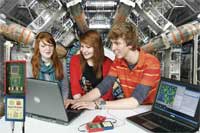
Image courtesy of the
Langton Star Centre
Although we are all curious about the world we live in, research is a pursuit usually reserved for full-time scientists and university students. Laboratory space and equipment are costly, and experiments take lots of time and patience. But, every so often, a lucky school student is given a unique chance to step into the shoes – or lab coat – of a scientist. Such opportunities are now becoming more accessible, thanks to teachers like Becky Parker.
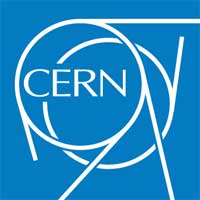
In 2007, Becky, who teaches physics in the UK, travelled 10 hours by coach with 50 of her students on an annual school visit to CERNw1, the world’s largest particle physics laboratory, in Geneva, Switzerland. That trip would prove to be a pivotal point in her career.
“When we returned from our visit to CERN, we heard about the Space Experiment Competition, run by the British National Space Centre – now UK Space Agencyw2 – and Surrey Satellite Technology Limited,” Becky says. “My students thought it would be a good idea to use particle detectors we had seen at CERN to measure cosmic radiation.”
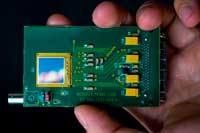
Image courtesy of Maximilien
Brice, CERN
The particle detectors, known as TimePix chips, were developed by the international, multi-institutional MediPix collaborationw3. Each MediPix and TimePix chip consists of a grid of pixels. The Medipix chip counts each light particle (photon); its important advantage compared to conventional techniques is that no signal whatsoever is measured if no photon enters. This means that there is no noise irrespective of the period of exposure. Unlike a MediPix chip, which just detects incoming particles, a TimePix chip uses an external clock with a frequency of up to 100 MHz as a time reference.
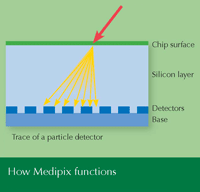
Click to enlarge image
Image courtesy of the Medipix
collaboration
“Michael Campbell, the spokesperson for the MediPix collaboration, had already thought the TimePix chips could be used in schools,” Becky says. “For the competition, my students designed the Langton Ultimate Cosmic ray Intensity Detector (LUCID), which uses four TimePix chips around the sides of a cube and one on its bottom to collect cosmic ray data.”
Cosmic rays are subatomic particles produced by a variety of events in outer space. They originate in the Sun, other stars, and in unidentified sources at the edge of the visible Universe. Cosmic rays travel unimpeded through vast stretches of empty space, and scientists can detect those that cross paths with Earth, revealing a wealth of information about the Universe. Becky’s students hoped to make their own contribution to cosmic ray detection.
“We entered LUCID into the competition and ended up in second place! We were awarded with the opportunity to fly LUCID on board the TechDemoSat satellite, planned to launch in 2012,” Becky says. “The initial LUCID team was three boys and three girls, but now we have 30 to 40 students involved at any given time. The students are working on protocols for sending commands when the experiment is in space – effectively setting up a mission control. The results from LUCID will yield valuable insights about the cosmic ray environment.”
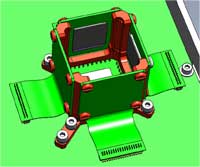
by the Langton school
Image courtesy of Surrey
Satellite Technology Limited
Wishing to share the excitement of LUCID, Becky has founded the CERN@school programme, in which smaller versions of LUCID are distributed to other schools. Students gather cosmic ray data, which is collected and made available to all the schools through the CERN@school websitew4. Ten UK schools are currently involved in the programme, which will soon expand to other schools in Europe and the USA.
“CERN@school students experience the excitement of being involved in real scientific research,” Becky says. “They collaborate with an international body of students and are encouraged to consider careers in physics and engineering. The project also allows teachers to act as practicing scientists, and researchers are given opportunities to work in school settings.”
Enthusiasm about scientific research is nothing new for Becky. After enjoying science and maths at school, she completed a physics degree at the University of Sussex, UK, and a master’s degree in conceptual foundations of science at the University of Chicago, USA. She returned to the University of Sussex for a teaching degree, choosing to teach physics because she “loved the subject and wanted people to be excited and inspired by physics”.
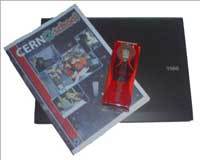
Image courtesy of the
Langton Star Centre
Becky Parker has now been a teacher for 18 years and has long taught at the Simon Langton Grammar School for Boys, which also enrolls girls in their last two years before university. She first visited CERN in 1993 and began an annual school trip to the institution in 1995, leading ultimately to the fateful 2007 trip that inspired LUCID.
Driven by the successes of LUCID and CERN@school, Becky recently founded the Langton Star Centrew5, which encourages students to perform research beyond the realm of particle physics. The centre offers students from many schools a chance to work with experts in plasma physics, astronomy and molecular biology. One of the centre’s plasma physics students has even published his work in a peer-reviewed journal (Hatfield, 2010).
“Students love getting involved in experimental work when the answers cannot be looked up on the next page,” Becky says. “They work with the very best scientists and engineers, and are treated as responsible scientists themselves. They work hard, yet have fantastic experiences, and they are far more likely to continue in science and engineering.”
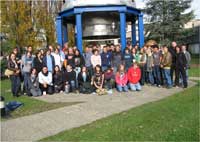
CERN
Image courtesy of the
Langton Star Centre
Indeed, since the initiation of the LUCID project, Simon Langton Grammar School has come to contribute 0.05% to 1% of all physics students at UK universities, more than doubling its previous numbers. The school also produces more engineers these days, and a high proportion of its female students continue in physics and engineering.
So what will Becky Parker do next?
“We hope to expand the CERN@school project,” she says. “With detectors in schools across Europe, we have the potential to do really exciting new physics. We are working out a way to store more data from LUCID and CERN@school by linking the schools together with the help of GridPP, which is a collaboration of particle physicists and computer scientists from the UK and CERN, forming the UK distributed computing network that is part of the wider CERN Grid. This grid will provide superior data analysis, taking the project to a new level of sophistication and potential.”
Teachers interested in getting their students involved in the CERN@school programme or the Langton Star Centre are encouraged to email Becky Parker at bparker@thelangton.kent.sch.uk
References
- Hatfield P (2010) Using line intensity ratios to determine the geometry of plasma in stars via their apparent areas. High Energy Density Physics 6(3): 301-304. doi: 10.1016/j.hedp.2009.10.001
Web References
- w1 – CERN is the world’s largest particle physics laboratory, based in Geneva, Switzerland. It is a member of EIROforum, the collaboration of inter-governmental scientific research organisations that publish Science in School. To learn more about CERN, see: www.cern.ch
- w2 – To find out more about the educational support by the UK Space Agency, visit www.bis.gov.uk/ukspaceagency and click on the ‘Discover and learn’ tab.
- w3 – More details of the MediPix collaboration can be found here: http://medipix.web.cern.ch/medipix
- w4 – To learn more about the CERN@school project, or even get involved, see: http://194.81.239.119
- w5 – For more information on the Langton Star Centre, see: www.thelangtonstarcentre.org
Resources
- Becky Parker is one of the teachers who participated in the ‘Why is science important?’ online project. See her video response to this question here: http://whyscience.co.uk/contributors/becky-parker
- For a review of the project website, see:
- Rüth C (2009) Review of the Why is science important? website. Science in School 13.





